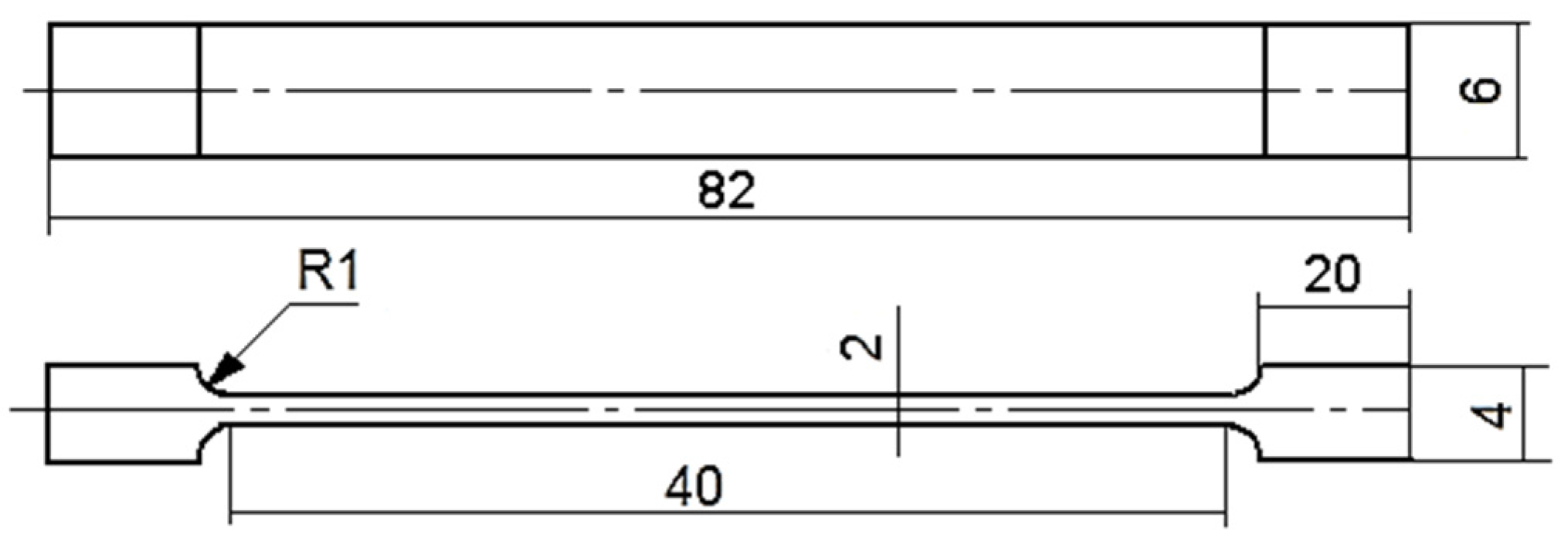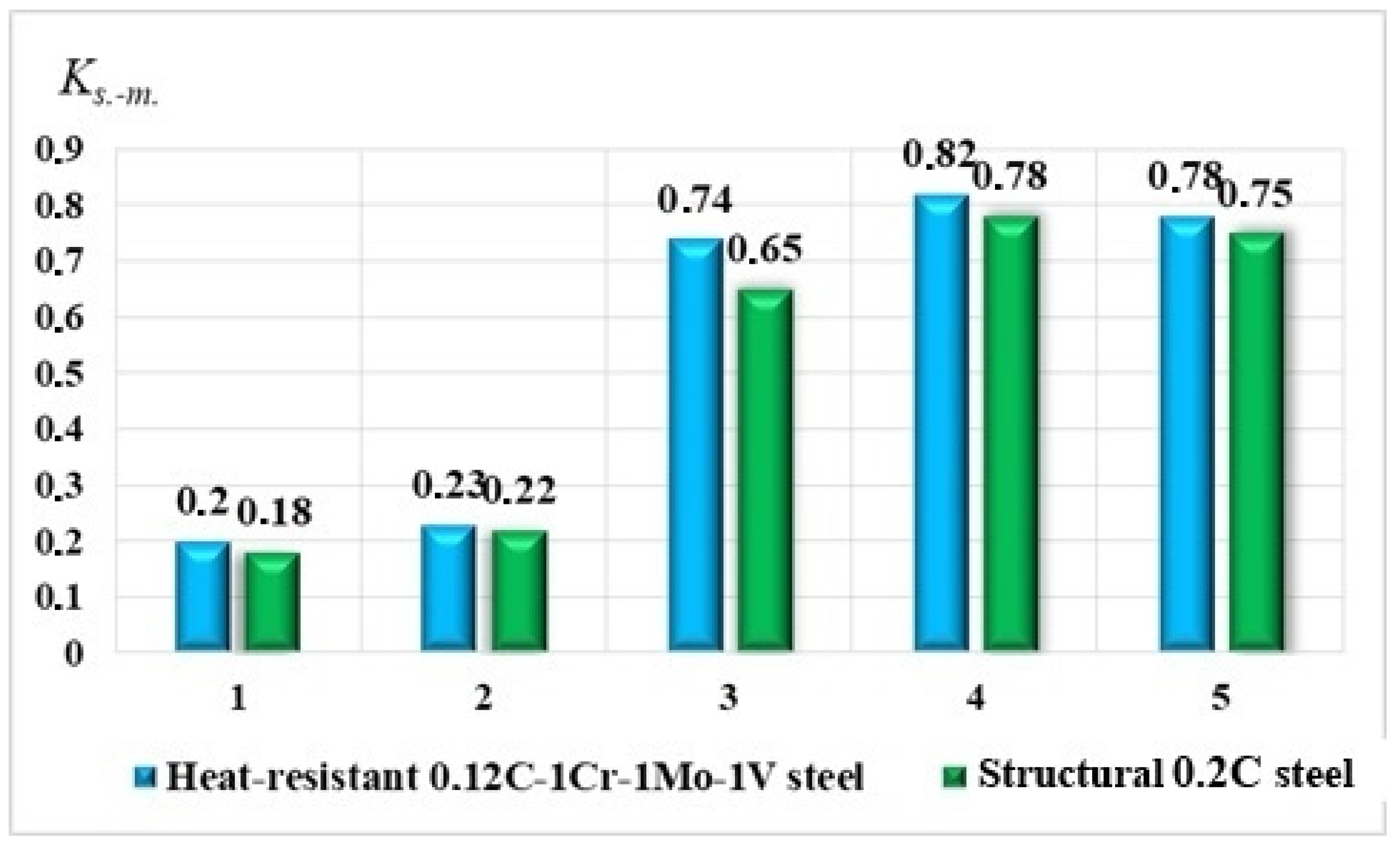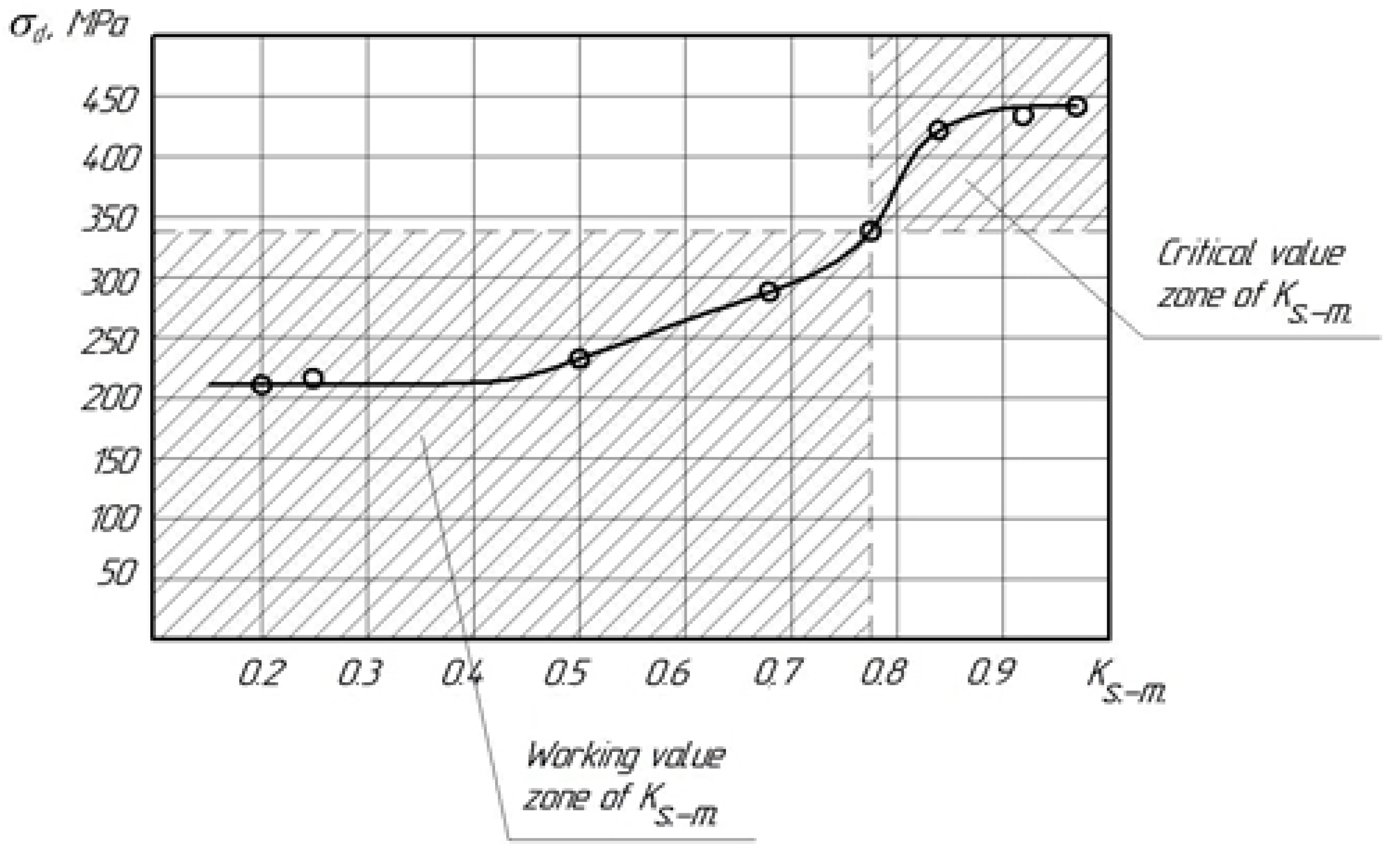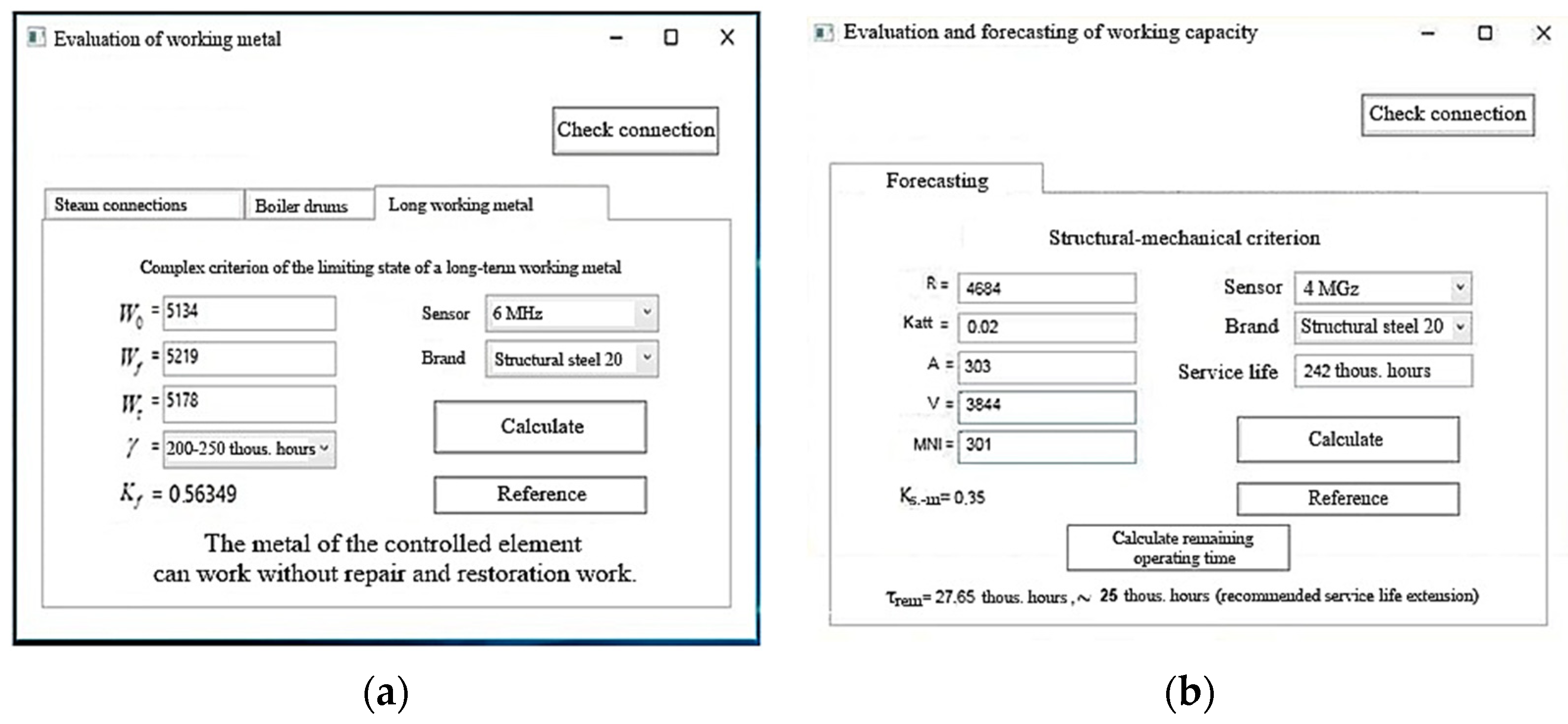Evaluating the Residual Life of Long-Term Equipment Made of Structural and Heat-Resistant Steel by Using the Structural–Mechanical Criterion
Abstract
1. Introduction
2. Materials and Methods
3. Theoretical Part
4. Calculation of the Structural–Mechanical Criterion and Residual Operating Time
5. Discussion
6. Conclusions
- A structural–mechanical criterion Ks.-m was developed based on the established relationships between the structural state, internal stress fields and stable localization of deformations with the characteristics of non-destructive tests in the metal of long-term power equipment made of structural 0.2 C steel and heat-resistant 0.12C-1Cr-1Mo-1V steel.
- It has been established that with the values of the structural–mechanical criterion Ks.-m ≤ 0.75 for structural steel 20 and Ks.-m ≤ 0.78 for heat-resistant 0.12C-1Cr-1Mo-1V steel, corresponding to the moment of stable deformation localization, it is recommended to replace the checked equipment components due to the exhaustion of the resource. However, the structural–mechanical criterion requires a large number of calculations that can be automated using intelligent systems.
- The proposed and justified approach to assessing and predicting the performance and residual life of long-running power equipment, based on the identified relationships between the structural and substructural states, internal stress fields and stable localization of deformations with the characteristics of non-destructive tests and the calculation of the structural–mechanical criterion, was applied at a number of power plants in the Kemerovo region—Kuzbass.
- When comparing the results of calculating the residual life of power equipment in an automated system, a high convergence was established with the results obtained when directly calculating the parameters of the microstructure (electron microscopy) and deformation parameters.
- An automated system for predicting the performance and evaluating the residual life of long-term power equipment has been developed, the basis of which is the structural–mechanical criterion, and has been tested in industrial conditions on a number of sections of steam and hot water steam pipelines made of structural 0.2 C steel and heat-resistant 0.12C-1Cr-1Mo-1V steel. The results of the calculation of the residual life according to the structural–mechanical criterion were compared with the results obtained by the expert organization during the examination of industrial safety. The discrepancy between the residual life assessment results did not exceed 5%.
Author Contributions
Funding
Institutional Review Board Statement
Informed Consent Statement
Data Availability Statement
Conflicts of Interest
References
- Rezinskikh, V.F.; Grin, E.A. Modern problems concerned with ensuring safe operation of heat-generating and mechanical equipment in extending its lifetime. Therm. Eng. 2013, 60, 16–23. [Google Scholar] [CrossRef]
- Chrysochoos, A.; Louche, H. An infrared image processing to analyse the calorific effects accompanying strain localisation. Int. J. Eng. Sci. 2000, 38, 1759–1788. [Google Scholar] [CrossRef]
- Sun, H.B.; Yoshida, F.; Ohmori, M.; Ma, X. Effect of strain rate on Luders band propagating velocity and Luders strain for an-nealed mild steel under uniaxial tension. Mater. Lett. 2003, 57, 4535–4539. [Google Scholar] [CrossRef]
- Avril, S.; Pierron, F.; Sutton, M.A.; Yan, J. Identification of elasto-viscoplastic parameters and characterization of Lüders behavior using digital image correlation and the virtual fields method. Mech. Mater. 2008, 40, 729–742. [Google Scholar] [CrossRef]
- Makhutov, N.; Gadenin, M.; Reznikov, D.; Nadein, V. Risk and industrial safety. Reliab. Theory Appl. 2022, 17, 138–143. [Google Scholar]
- Ababkov, N.; Smirnov, A.; Danilov, V.; Zuev, L.; Popova, N.; Nikonenko, E. Structural-Phase State, Mechanical Properties, Acoustic and Magnetic Characteristics in the Sustainable Deformation Localization Zones of Power Equipment Made of Structural and Heat Resistant Steels. Metals 2021, 11, 1638. [Google Scholar] [CrossRef]
- Antikain, P.A. Metals and Calculation of the Strength of Boilers and Pipelines; Energoservis: Moscow, Russia, 2001. [Google Scholar]
- Tyutin, M.R.; Botvina, L.R.; Sinev, I.O. Changes in the physical properties and the damage of low- and medium-carbon steels during tension. Russ. Metall. 2018, 2018, 671–676. [Google Scholar] [CrossRef]
- Botvina, L.R.; Sinev, I.O.; Zavyalov, A.D. On the time dependences of the fracture concentration parameter estimated by dif-ferent methods. Dokl. Earth Sci. 2021, 496, 80–85. [Google Scholar] [CrossRef]
- Makhutov, N.A.; Gadenin, M.M. Analysis and Control of the Strength, Useful Life, and Safe Operation Risks of Power Plants with Various Kinds of Energy Commodities. J. Mach. Manuf. Reliab. 2022, 51, 37–45. [Google Scholar] [CrossRef]
- Basalov, Y.G.; Lokoshchenko, A.M.; Teraud, V.V. Modeling of Creep and Long-Term Strength of Rods at Alternating Stresses. Mech. Solids 2020, 55, 589–594. [Google Scholar] [CrossRef]
- Larin, N.S.; Lokoshchenko, A.M.; Fomin, L. Dependence of Creep-Rupture Lifetime for Rods under Tension in an Aggressive Environment on the Shape of a Single-Cell Cross-Section. Mech. Solids 2019, 54, 1042–1050. [Google Scholar] [CrossRef]
- Fomin, L.V.; Basalov, Y.; Lokoshchenko, A.M. On accouning the influence of corrosion processes on delayed fracture of a rod under creep condition. Mech. Compos. Mater. Struct. 2019, 25, 327. [Google Scholar]
- Syromyatnikova, A.S.; Gulyaeva, E.M.; Alekseeva, K.I. Computational-Experimental Estimation of Strength Properties of the Metal of Long-Operating Gas Pipeline. Russ. Metall. 2016, 2016, 10. [Google Scholar] [CrossRef]
- Botvina, L.R.; Tyutin, M.R.; Levin, V.P.; Ioffe, A.V.; Perminova, Y.S.; Prosvirnin, D.V. Mechanical and Physical Properties, Fracture Mechanisms, and Residual Strength of 15Kh2GMF Steel for Oil Sucker Rods. Russ. Metall. 2021, 2021, 546–558. [Google Scholar] [CrossRef]
- Zharkova, N.A.; Botvina, L.R.; Tyutin, M. Damage accumulation stages in a low-carbon steel during uniaxial tension. Russ. Metall. 2007, 2007, 223–229. [Google Scholar] [CrossRef]
- Tyutin, M.R.; Botvina, L.R.; Zharkova, N.A.; Petersen, T.B.; Hudson, J.A. Evolution of Damage Accumulation in Low-Carbon Steel in Tension Condition. Strength Fract. Complex. 2005, 3, 73–80. [Google Scholar] [CrossRef]
- Botvina, L.R.; Tyutin, M.R.; Petersen, T.B.; Levin, V.P.; Soldatenkov, A.P.; Prosvirnin, D.V. Residual Strength, Microhardness, and Acoustic Properties of Low-Carbon Steel after Cyclic Loading. J. Mach. Manuf. Reliab. 2018, 47, 516–524. [Google Scholar] [CrossRef]
- Demina, Y.A.; Tyutin, M.R.; Marchenkov, A.Y.; Levin, V.P.; Botvina, L.R. Effect of Long-Term Operation on the Physical and Mechanical Properties and the Fracture Mechanisms of X70 Pipeline Steels. Russ. Metall. 2022, 2022, 452–462. [Google Scholar] [CrossRef]
- Botvina, L.R.; Tyutin, M.R.; Bolotnikov, A.I.; Petersen, T.B. Effect of Preliminary Cycling on the Acoustic Emission Characteristics of Structural 15Kh2GMF Steel. Russ. Metall. 2021, 2021, 32–41. [Google Scholar] [CrossRef]
- Botvina, L.R.; Kushnarenko, V.M.; Tyutin, M.R.; Levin, V.P.; Morozov, A.E.; Bolotnikov, A.I. Fracture Stages and Residual Strength of Pipe Steel after Long-Term Operation. Phys. Mesomech. 2021, 24, 475–485. [Google Scholar] [CrossRef]
- Danilov, V.I.; Smirnov, A.N.; Gorbatenko, V.V.; Orlova, D.V.; Danilova, L. Luders Deformation in Weld Joints. Steel Transl. 2018, 48, 87–92. [Google Scholar] [CrossRef]
- Makhutov, N.A.; Gadenin, M.M.; Cherniavsky, O.F.; Cherniavsky, A.O. Study of Material Properties under Complex Conditions of Low-Cycle Deformation. Inorg. Mater. 2022, 58, 1563–1570. [Google Scholar] [CrossRef]
- Makhutov, N.A. Generalized regularities of deformation and fracture processes. Her. Russ. Acad. Sci. 2017, 87, 217–228. [Google Scholar] [CrossRef]
- Makhutov, N.A.; Lepikhin, A.M.; Leshchenko, V.V. Scientific and Methodological Provision of Safety of Offshore Subsea Pipelines with Defects according to Risk Criteria. Inorg. Mater. 2022, 58, 1556–1562. [Google Scholar] [CrossRef]
- Barnett, M.R.; Nave, M.D.; Ghaderi, A. Yield point elongation due to twinning in a magnesium alloy. Acta Mater. 2012, 60, 1433–1443. [Google Scholar] [CrossRef]
- Wang, X.; Wang, L.; Huang, M. Kinematic and thermal characteristics of Lüders and Portevin-Le Châtelier bands in a medium Mn transformation-induced plasticity steel. Acta Mater. 2017, 124, 17–29. [Google Scholar] [CrossRef]
- Pchelintsev, A.V.; Rezinskikh, V.F. Studying the damageability and short-term mechanical properties of grade 10Kh9V2MFBR-Sh steel during its combined thermal and mechanical loading. Therm. Eng. 2011, 58, 170–173. [Google Scholar] [CrossRef]
- Grote, K.E. Antonsson Handbook of Mechanical Engineering; Springer: New York, NY, USA, 2008. [Google Scholar]
- Bayatanova, L.; Rakhadilov, B.; Kurbanbekov, S.; Skakov, M.; Popova, N. Fine structure of low-carbon steel after electrolytic plasma treatment. Materialpruefung 2021, 63, 842–847. [Google Scholar] [CrossRef]
- Segal, V.M.; Noskova, N.I.; Mulyukov, R.R. Severe Plastic Deformation: Toward Bulk Production of Nanostructured Materials; Nova Science Publishers, Inc.: New York, NY, USA, 2006. [Google Scholar]
- Gorbatenko, V.; Danilov, V.; Zuev, L. Elastoplastic transition in the material with sharp yield point. AIP Conf. Proc. 2015, 1683, 020058. [Google Scholar] [CrossRef]
- Murav’eva, O.V.; Muraviev, M.A.; Sintsov, M.A.; Volkova, L.V. Detecting Flaws in Pumping-Compressor Pipe Couplings by Magnetic, Eddy Current, and Ultrasonic Multiple-Shadow Testing Methods. Russ. J. Nondestruct. Test. 2022, 58, 248–258. [Google Scholar] [CrossRef]
- Danilov, V.; Orlova, D.; Zuev, L. On the kinetics of localized plasticity domains emergent at the pre-failure stage of deformation process. Mater. Des. 2011, 32, 1554–1558. [Google Scholar] [CrossRef]
- Zuev, L.B.; Gorbatenko, V.V.; Danilova, L.V. Model of plastic deformation and failure of solids. Russ. Phys. J. 2022, 64, 1666–1675. [Google Scholar] [CrossRef]
- Zuev, L.B. Chernov–Luders and Portevin–Le Chatelier deformations in active deformable media of different nature. J. Appl. Mech. Tech. Phys. 2017, 58, 328–334. [Google Scholar] [CrossRef]
- Campbell, F. Elements of Metallurgy and Engineering Alloys; ASM International: Novelty, OH, USA, 2008. [Google Scholar]
- Brent, F.; James, H. Transmission Electron Microscopy and Diffractometry of Materials; Springer: New York, NY, USA, 2013. [Google Scholar]
- Getsov, L.; Rybnikov, A.; Semenov, A.; Semenov, S.; Tikhomirova, E. Thermal fatigue of singlecrystal superalloys: Experiments, crack-initiation and crack-propagation criteria. Mater. Tehnol. 2015, 49, 773–778. [Google Scholar] [CrossRef]
- Gromov, V.E.; Yur’ev, A.B.; Morozov, K.V.; Ivanov, Y.F.; Alsaraeva, K.V. Structure, phase composition, and defect substructure of differentially quenched rail. Steel Transl. 2014, 44, 883–885. [Google Scholar] [CrossRef]
- Popova, N.A.; Nikonenko, E.L.; Klopotov, A.A.; Potekaev, A.I.; Bayatanova, L.B.; Nikonenko, A.V.; Kislitsin, S.B. Phase Composition and Thin Structure of Steel Surface after Plasma Electrolytic Carbonitriding. Russ. Phys. J. 2020, 62, 1794–1800. [Google Scholar] [CrossRef]
- Kozlov, E.; Zhdanov, A.; Popova, N.; Pekarskaya, E.; Koneva, N. Subgrain structure and internal stress fields in UFG materials: Problem of Hall–Petch relation. Mater. Sci. Eng. A 2004, 1–2, 789–794. [Google Scholar] [CrossRef]
- Botvina, L.; Tyutin, M. New acoustic parameter characterizing loading history effects. Eng. Fract. Mech. 2019, 210, 358–366. [Google Scholar] [CrossRef]
- Botvina, L.R.; Soldatenkov, A.; Levin, V.P.; Tyutin, M.R.; Demina, Y.A.; Petersen, T.B.; Dubov, A.; Semashko, N.A. Assessment of mild steel damage characteristics by physical methods. Russ. Metall. 2016, 2016, 23–33. [Google Scholar] [CrossRef]
- Botvina, L.R.; Petersen, T.B.; Soldatenkov, A.P.; Tyutin, M.R. Time dependences of acoustic signal characteristics during fracture of metal samples. Dokl. Earth Sci. 2015, 462, 475–478. [Google Scholar] [CrossRef]
- Wu, K.-T.; Jen, C.-K.; Kobayashi, M.; Blouin, A. Integrated Piezoelectric Ultrasonic Receivers for Laser Ultrasound in Non-destructive Testing of Metals. J. Nondestruct. Eval. 2012, 30, 1–8. [Google Scholar] [CrossRef]
- Labergere, C.; Rassineux, A.; Saanouni, K. Numerical simulation of continuous damage and fracture in metal-forming processes with 2D mesh adaptive methodology. Finite Elem. Anal. Des. 2014, 82, 46–61. [Google Scholar] [CrossRef]
- Yang, J.; Wang, G.; Xuan, F.; Tu, S.; Liu, C. Out-of-plane constraint effect on local fracture resistance of a dissimilar metal welded joint. Mater. Des. 2014, 55, 542–550. [Google Scholar] [CrossRef]
- Osovski, S.; Nahmany, Y.; Rittel, D.; Landau, P.; Venkert, A. On the dynamic character of localized failure. Scr. Mater. 2012, 67, 693–695. [Google Scholar] [CrossRef]
- Khokhlov, M.; Fischer, A.; Rittel, D. Multi-Scale Stereo-Photogrammetry System for Fractographic Analysis Using Scanning Electron Microscopy. Exp. Mech. 2012, 52, 975–991. [Google Scholar] [CrossRef]
- Pokluda, J.; Pippan, R.; Vojtek, T.; Hohenwarter, A. Near-threshold behaviour of shear-mode fatigue cracks in metallic materials. Fatigue Fract. Eng. Mater. Struct. 2014, 37, 232–254. [Google Scholar] [CrossRef]
- Ababkov, N.V.; Smirnov, A.N.; Nikitenko, M.S.; Pimonov, M.V.; Teleguz, A.S.; Nesterenko, K.S.; Medvedchikov, M.N. Software module for assessing the state of mining equipment based on regularities of changes in the structural-phase state and fields of metal internal stress. Bull. Kuzbass State Tech. Univ. 2022, 6, 50–58, (In Russian, abstract in English). [Google Scholar] [CrossRef]





| Steel | Mass Fraction of Elements, % | |||||||||
|---|---|---|---|---|---|---|---|---|---|---|
| C | Si | Mn | Cr | Ni | Mo | S | P | V | Fe | |
| 0.2 C steel | 0.17–0.24 | 0.17–0.37 | 0.35–0.65 | Up to 0.25 | Up to 0.25 | Up to 0.25 | Up to 0.04 | Up to 0.035 | Up to 0.08 | ~98 |
| 0.12C-1Cr-1Mo-1V | 0.08–0.15 | 0.17–0.37 | 0.4–0.7 | 0.9–1.2 | Up to 0.3 | 0.25–0.35 | Up to 0.025 | Up to 0.03 | 0.15–0.3 | ~96 |
| Steel | Pipe Size, mm | Operating Time, Thousand Hours | Quantity, pcs. | Residual Resource, Thousand Hours |
|---|---|---|---|---|
| Automated system (calculation duration—70.5 h) | ||||
| 0.2 C steel | Ø133.0 × 13.0 | 219–242 | 26 | 51.2–74.6 |
| 0.2 C steel | Ø133.0 × 13.0 | 219–242 | 7 | 25.3–48.5 |
| 0.2 C steel | Ø133.0 × 13.0 | 219 | 3 | less 25 |
| 0.12C-1Cr-1Mo-1V | Ø133.0 × 17.0 | 180–360 | 19 | 52.6–72.8 |
| 0.12C-1Cr-1Mo-1V | Ø325.0 × 43.0 | 305–343 | 6 | 26.4–49.1 |
| 0.12C-1Cr-1Mo-1V | Ø133.0 × 17.0 | 284–318 | 4 | <25 |
| Expert organization (calculation duration—112 h) | ||||
| 0.2 C steel | Ø133.0 × 13.0 | 219–242 | 25 | 50.4–77.8 |
| 0.2 C steel | Ø133.0 × 13.0 | 219–242 | 8 | 25.2–49.1 |
| 0.2 C steel | Ø133.0 × 13.0 | 219 | 3 | <25 |
| 0.12C-1Cr-1Mo-1V | Ø133.0 × 17.0 | 180–360 | 19 | 52.1–74.7 |
| 0.12C-1Cr-1Mo-1V | Ø325.0 × 43.0 | 305–343 | 6 | 25.9–49.4 |
| 0.12C-1Cr-1Mo-1V | Ø133.0 × 17.0 | 284–318 | 4 | <25 |
Disclaimer/Publisher’s Note: The statements, opinions and data contained in all publications are solely those of the individual author(s) and contributor(s) and not of MDPI and/or the editor(s). MDPI and/or the editor(s) disclaim responsibility for any injury to people or property resulting from any ideas, methods, instructions or products referred to in the content. |
© 2023 by the authors. Licensee MDPI, Basel, Switzerland. This article is an open access article distributed under the terms and conditions of the Creative Commons Attribution (CC BY) license (https://creativecommons.org/licenses/by/4.0/).
Share and Cite
Ababkov, N.; Smirnov, A.; Danilov, V. Evaluating the Residual Life of Long-Term Equipment Made of Structural and Heat-Resistant Steel by Using the Structural–Mechanical Criterion. Metals 2023, 13, 1075. https://doi.org/10.3390/met13061075
Ababkov N, Smirnov A, Danilov V. Evaluating the Residual Life of Long-Term Equipment Made of Structural and Heat-Resistant Steel by Using the Structural–Mechanical Criterion. Metals. 2023; 13(6):1075. https://doi.org/10.3390/met13061075
Chicago/Turabian StyleAbabkov, Nikolay, Alexandr Smirnov, and Vladimir Danilov. 2023. "Evaluating the Residual Life of Long-Term Equipment Made of Structural and Heat-Resistant Steel by Using the Structural–Mechanical Criterion" Metals 13, no. 6: 1075. https://doi.org/10.3390/met13061075
APA StyleAbabkov, N., Smirnov, A., & Danilov, V. (2023). Evaluating the Residual Life of Long-Term Equipment Made of Structural and Heat-Resistant Steel by Using the Structural–Mechanical Criterion. Metals, 13(6), 1075. https://doi.org/10.3390/met13061075







